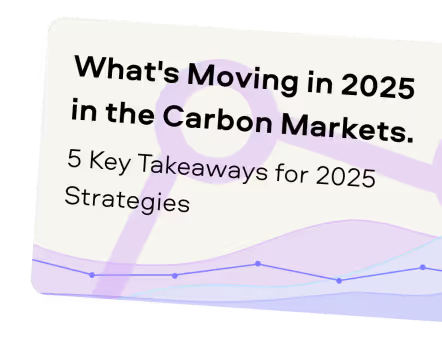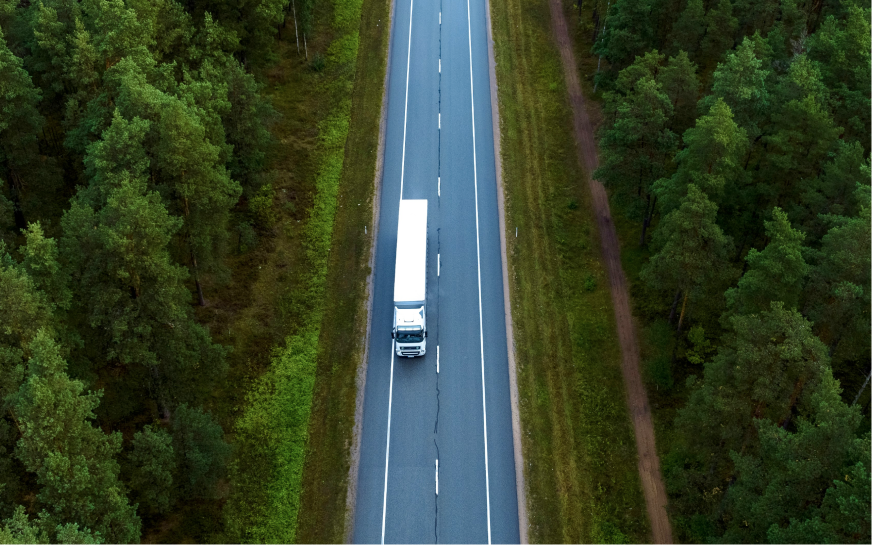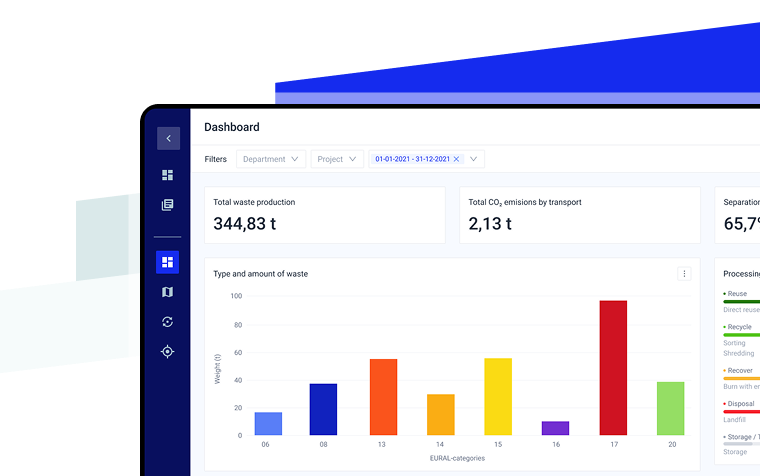“Over the years we’ve invested significantly in our field data team - focusing on producing trusted ratings. While this ensures the accuracy of our Ratings, it doesn’t allow the scale across the thousands of projects that buyers are considering.”
For more information on carbon credit procurement trends, read our "Key Takeaways for 2025" article. We share five, data-backed tips to improve your procurement strategy.

One more thing: Connect to Supply customers also get access to the rest of Sylvera's tools. That means you can easily see project ratings and evaluate an individual project's strengths, procure quality carbon credits, and even monitor project activity (particularly if you’ve invested at the pre-issuance stage.)
Book a free demo of Sylvera to see our platform's procurement and reporting features in action.
Why 2030 Is a Tipping Point for Enterprise Waste
The future of waste management is defined by its move from the back office to the boardroom. The year 2030 is not only a milestone for the UN Sustainable Development Goals, but also a critical checkpoint for enterprises: just five years remain to align company strategies with global targets.
Three forces stand out:
- Regulatory drivers: From a European perspective, the future of waste management will be shaped by CSRD/ESRS regulations, ISO 14001, and EPR frameworks. The Corporate Sustainability Reporting Directive (CSRD), and specifically ESRS E5, requires audited, site-level reporting of waste outflows. ISO 14001 alignment and the expansion of Extended Producer Responsibility (EPR) schemes make compliance more data-intensive than ever.
- Cost and risk pressures: Rising transport costs, fragmented vendor networks, and growing audit exposure push CFOs and QHSE managers to scrutinise every tonne.
- Resource scarcity: As raw materials become increasingly scarce and expensive, enterprises must optimise the use of resources, extend material lifecycles, and reduce environmental impact.
Together, these forces make 2030 a decisive turning point. Companies that delay risk higher costs, compliance failures, and reputational damage. Those who invest early in verified, centralised waste management data will gain efficiency, build resilience, and transform waste materials into valuable resources, all while aiming to reduce greenhouse gas emissions from traditional waste disposal methods to sustainable practices that support the circular economy.
With these forces in play, here are ten trends that define the future of enterprise waste management:
The 10 Trends Defining the Future of Waste Management
#1 AI-Driven Waste Analytics
Artificial intelligence is revolutionizing waste management by transforming how enterprises handle data. Instead of manually cleaning spreadsheets or reacting to after-the-fact reports, AI can integrate fragmented datasets, detect anomalies, and surface trends across thousands of records. This turns raw waste flows into actionable insights that support sustainable practices and circular economy principles—making data both faster and smarter.
What to do now: Centralise your waste data and apply artificial intelligence to enrich, extract, and analyse it. geoFluxus uses AI to enrich data, extract data from PDF documents, and analyse data.
#2 CSRD/ESRS-Ready Data
The future of waste management lies in the realm of being reshaped by regulation. The CSRD requires companies to report verified waste outflows under ESRS E5, with audit-ready traceability across sites. Relying on spreadsheets or fragmented waste management systems won’t stand up to this level of scrutiny. To stay ahead, enterprises need robust data pipelines and sustainable waste management practices that ensure consistency and transparency, while aligning with circular economy principles to conserve natural resources .
What to do now: Map current fields to ESRS requirements and replace spreadsheets with systemised reporting. Our reporting module produces audit-ready reports.
#3 Circularity Mapping for Resource Recovery
With raw materials increasingly scarce and costly, enterprises can’t afford to treat waste as simple outflows. Visibility into material flows is essential to uncover opportunities for waste reduction, reuse, and higher-value recycling. Circularity KPIs—such as reuse rates, recycling rates, and resource recovery—are now central to measuring how effectively resources are kept in play under circular economy principles.
What to do now: Map your material streams and track reuse KPIs. Our platform shows where materials go and highlights opportunities for value recovery.
#4 Supplier Benchmarking
Improving waste treatment starts with understanding where you stand today. In the waste management industry, benchmarks are essential: without them, it’s impossible to know whether your recycling rates, compliance reliability, waste separation efficiency, or transportation costs are strong or lagging. By comparing processor performance against peers, enterprises can uncover realistic areas for improvement, reduce environmental impact, and negotiate better outcomes. Benchmarking also highlights where innovative waste management solutions and recycling technologies can drive measurable gains.
What to do now: Compare how different processors treat your waste and track performance against industry averages. Our platform benchmarks processing performance automatically, so you always know if you’re performing below or above average.
#5 Decarbonising Waste Logistics
Transport may be one of the most actionable ways to cut carbon in waste management. Waste often travels long distances—even across borders—when closer treatment options exist. Every unnecessary kilometre garbage trucks drive increases transportation costs, greenhouse gas emissions, and the overall environmental footprint.
What to do now: Inventory how many kilometres your waste streams travel today and identify opportunities for shorter routes or closer processors. Our optimisation insights calculate distance and CO₂ per km to highlight smarter logistics options.
#6 Greenhouse Gas Emissions from Waste
Scope 3 waste emissions include both greenhouse gases from transport and from treatment. Transport can already be measured today, while treatment emissions—such as methane from landfill—are harder to quantify but remain among the most harmful greenhouse gases. By 2030, enterprises will be expected to have a clear and defensible picture of Scope 3 emissions from waste.
What to do now: Build a baseline by linking transport data to carbon factors, and prepare to expand reporting as treatment methodologies and standards mature.
#7 Packaging & EPR Compliance
Packaging and plastics are under mounting scrutiny, with Extended Producer Responsibility (EPR) schemes expanding rapidly across Europe. Reporting is shifting into detailed requirements—covering weight, composition, recyclability, and destination of each packaging type. Getting this right reduces regulatory risk, improves recycling, and minimises the footprint of plastic waste.
What to do now: Track packaging flows by material type and destination to prepare for growing EPR reporting requirements.
#8 Secondary Material Marketplaces
What one company sees as waste can often be a valuable resource for another. By 2030, digital platforms and better data will make it easier to match material outflows with industries that can reuse them. This shift supports waste diversion, reduces landfill, and prevents environmental harm. Opportunities span streams from electronic waste to organic materials, where better waste sorting and innovative solutions can reduce waste and unlock new value.
What to do now: Identify waste streams with reuse potential and explore cross-industry buyers. Our material flow visibility highlights reusable outputs.
#9 Real-Time Waste Dashboards for Execs & Auditors
Executives and auditors can’t act on outdated or fragmented reports. Real-time dashboards consolidate waste data into a single system, giving leadership a clear view of performance and environmental impact. For boards, this means smarter decisions; for auditors, every datapoint is linked to a full audit trail.
What to do now: Define standard KPIs and make them visible in real-time dashboards. Our dashboards provide live insights across sites with a complete audit trail for every datapoint.
#10 Breaking Data Silos
Waste data often lives in many places—procurement tools, EHS systems, spreadsheets, and sustainability platforms. This fragmentation leads to duplication, inconsistencies, and blind spots that undermine compliance and circular performance. By 2030, enterprises that unify their data will have a decisive advantage: faster reporting, stronger audits, and clearer insights to act on.
What to do now: Map where your waste data lives and consolidate into one verified system of record. geoFluxus integrates data across departments, giving enterprises a single trusted source of waste intelligence.
What This Means for Enterprise Teams (QHSE, Sustainability, Procurement)
- QHSE: Move beyond fragmented spreadsheets to verified, audit-proof data. Break down silos and set up robust pipelines, supported by real-time dashboards, so every datapoint is traceable and audit-ready.
- Sustainability: Make circularity measurable. Track KPIs such as reuse, recycling, and recovery rates, alongside carbon from transport and treatment, to measure progress toward 2030 targets.
- Procurement: Go beyond cost comparisons by benchmarking vendors on treatment types, recycling outcomes, compliance reliability, and transport distances. Use these insights to negotiate smarter contracts with transparent SLAs.
A 90-Day Action Plan to Get Future-Ready
- Days 0–30: Start small by selecting one or two pilot locations. Avoid getting lost in the scale of the challenge—focus on gathering all waste data sources for those sites (documents, spreadsheets, invoices) and begin standardising them.
- Days 31–60: Map your data to organisational KPIs and reporting requirements. Set up dashboards and anomaly checks, then analyse the results: Which streams travel too far? How are you performing on recycling rates, or reliance on landfill and incineration?
- Days 61–90: Identify improvement opportunities. Where can you do better? Which materials can be recovered, and are there closer processors available? Translate insights into operational changes. This will evolve into a longer-term plan, but the sooner you identify what to improve, the more likely you are to achieve your goals.
👉 Ready to take the next step? Let’s explore how geoFluxus can get you results within 30 days.
Waste KPIs to Track for a Greener Future
To future-proof your waste strategy, start tracking the right metrics now. These KPIs will help you measure operational efficiency, compliance readiness, and sustainability impact—while building a defensible baseline for climate reporting.
Recommended KPIs include:
- Recycling & reuse rate — aim for 85%+ across streams
- Separation rate — target 85%+ (higher separation improves reuse potential)
- Landfill & incineration rate — keep below 5%
- Total CO₂ from waste — transport + treatment
- €/tonne processing cost — compare efficiency across sites and vendors
- Transport kilometres per tonne — highlight distance and cross-border inefficiencies
Pitfalls to Avoid
- Treating waste data as an afterthought in CSRD compliance
Financial audits usually pull from one system with invoices mapped. Waste audits are different: data sits in scattered spreadsheets, PDFs, and invoices from multiple vendors. Without an audit trail, tracing a single datapoint becomes a nightmare—multiplied by hundreds. Setting up traceability from the start avoids this headache. - Getting locked into vendors without benchmarking
Processor contracts are often multi-year. Without benchmarks, you risk being stuck with poor performance and higher costs. Knowing how waste management companies compare on treatment, recycling, and transport puts you in a stronger negotiating position. - Measuring waste volumes without linking to carbon and circularity
Volumes alone don’t reveal environmental impact. Waste must be tied to CO₂, recycling, and recovery rates to show real progress in circular economy performance. - Reporting without enabling action
Reports that sit on a shelf waste the effort of collecting data. Their real value is in driving change—optimising routes, switching to closer processors, or improving recovery.
Conclusion
By 2030, waste management will be inseparable from enterprise strategy. Rising waste generation, municipal solid waste, and food waste are pushing companies to adopt innovative waste management technologies and work with companies that can deliver measurable results. The focus is shifting from disposal to minimizing waste generation, recovering recyclable materials, and cutting potent greenhouse gases.
Enterprises that act now—by unifying data, embracing circular economy principles, and practicing environmental stewardship—will move beyond traditional waste disposal and help build a greener future.
At geoFluxus, we help enterprises transform waste into opportunity—enriching and integrating data, benchmarking processor performance, and making circularity measurable. The next five years will determine who leads in sustainable waste management.
FAQs
What is the future of waste management for enterprises?
By 2030, waste management will move from disposal-focused to data-driven. Success will be defined by compliance readiness (CSRD/ESRS, EPR, ISO 14001), carbon accountability through Scope 3 reporting, and reducing waste generation with measurable circularity KPIs like reuse and recovery rates.
How does AI improve waste reporting and compliance?
AI accelerates the process of making waste data usable. It can enrich fragmented datasets, extract information from PDF documents, and analyse large volumes of records to detect anomalies, gaps, or outliers—turning raw data into audit-ready insights.
What KPIs matter most for the circular economy?
Key metrics include: recycling & reuse rate (target 85%+), separation rate (target 85%+), landfill & incineration rate (keep below 5%), total CO₂ from waste (transport + treatment), €/tonne processing cost, transport kilometres per tonne, and % verified waste data coverage.
How does geoFluxus help with ESRS E5 and ISO 14001?
geoFluxus automates the mapping, verification, and reporting of waste flows. By consolidating data across systems and creating full audit trails, the platform produces audit-proof outputs aligned with ESRS E5, CSRD requirements, and ISO 14001 standards.









